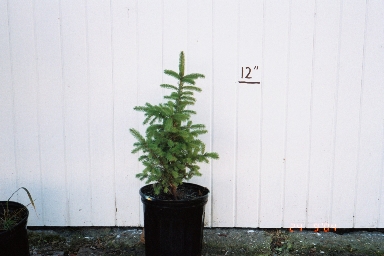The Black Hill Spruce is a first cousin of the White Spruce that developed in the Black Hills of South Dakota. They grow in a narrow area above 5000 ft in elevation. It is a slow (6”-12” per year) growing very compact evergreen.
15 year old Black Hills Spruce
It will grow up to 40+ft tall and 20+ ft wide and as with the white spruce is very wind firm and is not damaged by heavy snow or ice storms. this tree can live 80 or more years in windbreaks west of Iowa. Deer will normally not eat this species unless nothing else is available.
It will grow well in hardiness zones from 3-6 and does well in a variety of soils, with well drained being the best. It will survive dry and hot areas better than other spruces and seems to get along fine with 10” of rain a year or more.
Fungal diseases in wet areas and times of excess rainfall can effect the Black Hills spruce. Putting them on an outside row and not in the middle of a windbreak will lessen this problem. They are rarely effected by insect pests and occur usually on older, newly planted, or stressed trees.
A 2’ tall potted tree should be over 5 ft tall in 5 years in good soil with adequate moisture and most of all, total grass and weed control with no mulch. Spacing--single row 16 ft apart, double row 18 ft apart, multiple rows 20 ft apart with trees staggered from the other row.
The Black Hills spruce is a recommended windbreak tree west of Iowa. East of Nebraska we have seen a lot of problems with this tree and excessive rain and moisture, causing fungal problems the same as the Colorado Spruce and rarely growing over 30 ft tall.. We do not think this is a good tree for the first 3 rows of a basic windbreak, if a larger windbreak with more rows was used they could be put in as the extra rows. The White Spruce we think is a better plant for a windbreak if you like the look of this tree, and usually they look very similar and since they are first cousins in the tree family, without the problems associated with the Black Hills Spruce. They do seem to do well, not in a windbreak but alone where sun and wind can keep the fungal diseases at bay.
Kelly Tree Farm, 191 Quincy Ave. Clarence IA 52216 - PH: 563-452-4300 - ktf@netins.net


